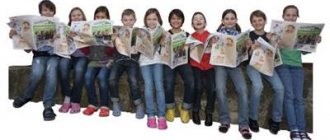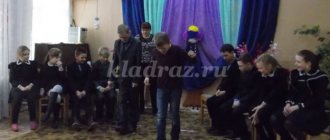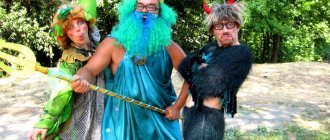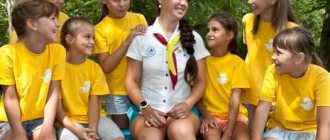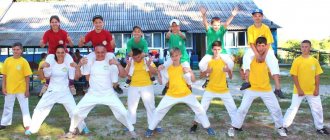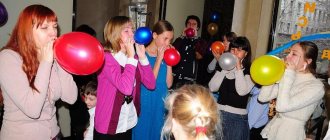Games for children outside in a circle
"Contact"
The players form a large circle. The presenter stands in the center of it and names the signs and the first letter of the intended word. The rest need to guess this word, but they cannot name it right away. Guessing the word
the player says: “There is contact!” Only after this does he have the right to say the word. If the answer is correct, the player becomes the leader; if the answer is wrong, he receives a penalty point, and the leader names the second letter in the intended word.
“Who will remember more?”
To play you will need 15 - 20 small items. The presenter lays them out on the table and covers them with a scarf. Then, after 30 seconds, it opens items. Kids memorize them, and then write down the names on sheets of paper. The one who remembers the most items wins.
"Say the sixth"
The participants of the game form a circle. The leader in the center quickly names 5 trees (birds, animals, etc.), and the player to whom he addresses must be able to name the sixth one before the leader finishes the list. If the player answered correctly, he becomes the leader.
"Find differences"
The players form a circle. The leader is in the center and carefully examines the players. Then he leaves the center and turns away. At this time, the players change places. the leader enters the center and places them in their places. When playing this game, participants can change not only places, but also clothes and shoes.
"Stand still"
The players form a circle. The leader walks inside it and, stopping in front of someone, says loudly: “Hands!” The one to whom the leader is addressing remains standing quietly, and his neighbors must raise their hands: the neighbor on the right - right, the neighbor on the left - left. The one who makes a mistake becomes the leader. Other commands may be used in the game.
"Journey"
The players form a large circle and “go on a journey” - they move in a circle to the right, while simultaneously performing actions that the leader calls: walking along the road, riding a bicycle, jumping on a horse, etc.
"Net"
Players sit in pairs in a circle, one behind the other, facing the center. The kids in the inner circle join hands - this is a “fishing net.” The kids in the outer circle are “fish”. At the signal “Fish!” the net opens (everyone raises their hands), and the fish “swim” freely under it. At the signal “Network!” the players in the inner circle give up, the net closes and the fish that did not have time to jump out join the players in the inner circle. The game continues until all the fish are in the net. The last, most agile fish wins.
"The sun shines for those who..."
The participants of the game form a circle. The leader is in the center of it and says: “The sun shines for the one who has the clock.” Children with watches must change places. The leader also strives to take an empty seat in the circle. The player who is left without a place becomes the leader. The game continues with a different condition.
"Orchestra"
The participants of the game form a circle with the leader in the center. A conductor is selected from among the players - he imitates playing some musical instrument. Participants repeat these movements. The conductor then quietly points to the player who will be the new conductor and "change" instrument. They repeat new movements again. The presenter’s task is to notice who is changing movements, i.e. to find the conductor. If the conductor is identified, he becomes the presenter.
"River, hummock, mountain"
The players form a circle. At the presenter’s signal “River!” The players must extend their arms in front of them. At the signal “Kupina!” - Sit down. At the signal “Mountain!” stand on tiptoes and clasp your hands above your head. The players' task is to quickly and correctly execute commands. The leader’s task is to complicate the execution of commands by indicating movements other than those that he calls.
"Freezing"
Players form a large circle and extend their arms forward. “Frost” runs in a circle to the music and tries to touch the players’ hands with a balloon to “freeze” them. The players' task is to accept hands in time. Whoever does not have time to do this drops out of the circle or becomes an assistant to the “frost”.
We have described games for children on the street, now we will describe the scenarios of two relay races.
Newspaper tournament
Newspaper is an accessible and low-cost material. Use it when organizing summer activities for children. We have collected here some competitions using newsprint. Surely, you can supplement them with your own games and relay races.
Competitions for the newspaper tournament
- "Presentation". Find suitable letters and words for self-presentation on the pages of newspaper sheets. Cut them out and paste them on a piece of album paper so that you get a small coherent story. Time to complete the task is 15 minutes.
- "Snowball". On command, crumple a sheet of newspaper until you get a ball, holding it in your outstretched hand. The winner is the one who completes the task faster.
- "Hundred Meter". Make shoes from sheets of newspaper, wrapping them around your feet and tying them with laces. Having put on your shoes, run a hundred meters. The fastest runner is revealed.
- "Musical pause". Teams are invited to create an ensemble and, using newspaper sheets as musical instruments, play “Song about Summer” (“This is what our summer is...”). You can pat, tear the newspapers or rustle them.
- "Newspaper ball." Balls crumpled up from newspapers will be used for throwing. Instead of a basket, you can use a cardboard box. Throwing options can be very different: with the right and left hand, from behind the head, from under the leg, with your back turned, etc.
- "Origami". Fold an airplane, a boat, or a cap out of a piece of newspaper faster than your opponents.
- "Reactive plane". Goal: fly your paper plane further than your opponents. Use the airplanes folded in the previous competition.
- "Water-carrier." Carry water in newspaper bags, trying to fill your glass faster than your opponents.
- "Wheelball." Make a fan from newspaper sheets for each of the participants. With their help you need to throw the balloon onto the enemy field. Task: prevent the ball from falling on your site.
- "Useful reading." Each team should be given an identical copy of the newspaper. The presenter announces a word or phrase that is somewhere on the pages of these newspapers. The team that finds the given word faster will be the winner.
- "Accountants". Count the number of punctuation marks and letters in a given paragraph. Whoever names the number correctly the fastest is the winner.
- "Experts" Goal: find out who knows more newspaper names. You can call them one by one. The team that, in turn, could not remember anything else loses. You can write names on a piece of paper, then the presenter simply counts the number of names.
- "Crossing". Get to the finish line using two newspapers. You should shift newspapers, stepping from one to another.
- "Islands". The spread newspaper should accommodate as many team members as possible. If the teams are small in composition, then the newspapers should be folded.
- "Fashion designers". Create a dress or suit from several sheets of newspaper and tape and hold a fashion show.
- "Sculptors". Tear a sheet of newspaper to give it a finished shape, for example, a star, a flower, a snowflake. The “sculptor” who creates the most beautiful and original figure wins.
- "Shooting Range." While forming balls from newspaper sheets, knock down a plastic bottle.
- "Surprise". Any item is wrapped in a large number of layers of newsprint. The winner is the team that gets the gift the fastest.
- “No matter how long the rope hangs...” Make a “rope” of maximum length from newspapers. The task completion time is 2 minutes. Whichever team has the longest “rope” wins.
- “Waste paper collectors” – final competition. After previous competitions, there will probably be a lot of paper lying around. With this last test of the teams, you can kill two birds with one stone: hold the final competition and restore order by cleaning the territory. Give each team one garbage plastic bag and ask them to collect all the garbage that is nearby. The team whose bag is the heaviest at the end of the competition wins.
Relay races for children - scenario
I version of the relay
Two teams of equal strength take part in the relay race. They complete one stage of the relay, move on to the second, and so on until the finish. There are judges at the venue of each stage who monitor the progress of the stage and record points. Each team member receives 1 point for successfully completing a stage; if an error was made, 0.5 points, and if the stage is not completed, the point is not counted.
Stage I - “Air crossing” Between two trees (or pillars) 2 ropes are stretched parallel to each other so that children, standing on the bottom rope, can reach the top rope with outstretched arms. For the safety of preschoolers and schoolchildren, the lower rope is stretched above the ground at a level of 30 - 50 cm. If the rope is tensioned higher, you need to organize belay for the children using a climbing harness.
technology. The length of the crossing is 1.5 - 2 m. Children take turns going through the air crossing, while they hold on to the top rope with their hands and step on the bottom rope with their feet. There should not be more than one person on the rope.
Stage II - “Trap” The “trap” is made from hoops, branches, boards, thick wire, chairs, etc. Its height should be such that the participant can crawl under it on his belly. The length of the trap is 2 - 3 m. The task of the children is to crawl under the trap so as not to disturb it. Children go through this stage one at a time.
Stage III - “Walk on a log”, competitors must walk along a log or a long bench without assistance. The length of the log is 2 - 3 m. During the stage there should be only one child on the log.
Stage IV - “Go around the obstacle” 6 pegs are driven into the ground, the distance between them is 0.5 - 0.8 m from each other. Competitors grasp a small ball with their knees, walk around the pegs with it and return in a straight line back, still holding the ball with their knees. The ball is then passed to the next team member.
Stage V - “Pendulum” A rope is suspended from a tree or pole with a large knot tied at the end, which is located at a distance of 80 cm from the ground. This is a pendulum. The starting line is drawn in front of him. Competitors grab the rope with their hands, run towards the start line, jump and land behind the finish line.
Stage VI - “Walk over the bumps” There are bumps on the ground - planks, car tires, cardboard circles, etc. Children must run over the bumps WITHOUT stepping on the ground.
II version of the relay
Stage I - “Fast walker” Teams stand in ranks opposite each other. The captains each receive a hoop, put them on themselves, then lower the hoops to the ground, step over them and pass them
to the next participant. The last player in the column again gives the penultimate hoop, and the hoop thus “goes” in the opposite direction - to the captain. The team whose captain receives the hoop first wins.
Stage II - “pulled” A line is drawn in the middle of the site. The teams stand on opposite sides of it. The members of each team lock elbows, and then both teams join in the same way. At the signal, the children begin to pull each in their own direction, trying to break the chain of the enemy team or pull him over the dividing line.
Stage III - “Porters” At the end of the site there is a long bench on which 10 pins or small balls lie. At the opposite end of the platform, 15 - 20 steps from the bench, there are 2 stools. The distance between them is 5 - 6 steps. team captains
sit on stools. They are the “porters”. Each of them, blindfolded, needs to move 5 pins from the bench to their stool. You can only carry one pin at a time. All team members participate in the relay race. The speed of completing the task is estimated.
Stage IV - “Cock Fight” A circle with a diameter of 3 m is drawn on the site. A pair of players enter it (one from each team). Each player takes the starting position: standing on one leg, with his hand
holds the other leg. At the signal, the “fight” begins: the competitors try to push their opponent out of the circle with their shoulders. The one who stays inside wins.
Stage V - “Go around the obstacle” Teams of two form 2 columns, each at its own start. In each pair, the players are tied with their legs - the right one of one player to the left of the other. Pairs need to run around the pins, which are spaced 0.8 - 1 m from each other, then return in a straight line to the starting point and clap the palms of the next players, who continue the relay.
Stage VI - “jump over the ditch” 2 lines are drawn on the ground, at a distance of 0.8 - 1.5 m from each other. This is a "moat". Behind it is a sand mound or mats. Competitors take turns jumping over the ditch. For each successful jump, the team receives 1 point.
Help the kids play games for children on the street together and hold interesting relay races, it will be fun!
Tips for parents
Children playing together with their parents benefits both. Children experience joy and bright emotions, and adults can get to know their child better and become closer to him. This is important in order to make childhood unforgettable and interesting for the child. Therefore, do not be lazy to play with him, do not be afraid to seem frivolous and funny, be a friend to him.
The games discussed in the article can be played both in the yard of the house and in a preschool or summer camp.
If you liked the article, please share a link to it
